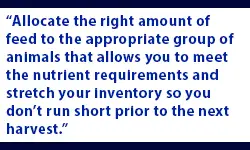
7 steps to maximize income over feed costs
 By Rod Martin
By Rod MartinEvaluating feed costs is a double-edged sword. Because it’s your largest expense, cost-cutting measures could be extremely significant in reducing cost of production. On the other hand, milk production and components are the economic engine that drives cash flow. Saving 20 cents per cow daily in feed costs while losing 50 cents in productivity is not a good economic tradeoff decision.
Production potential for each farm is different due to all the moving parts, but you need to budget a minimum productivity threshold and then determine the investment cost to produce an extra pound of milk or fraction of a percent on your components. It all comes down to income over feed costs (IOFC).
Work closely with your consulting nutritionist to evaluate on-farm nutritional strategies that may improve the dairy’s cash flow.
Step 1: Define your productivity goal based on key on-farm variables that may have significant impacts on production and component goals, such as:
- 2x or 3x milking schedule
- Cow comfort
- Forage quality
- Genetic potential
- Bunk management
- Transition care
- Parlor operation
- Stocking density
- Labor efficiency
- Protocol compliance
Step 2: Maximize homegrown feeds. Growing, harvesting, and storing high-quality homegrown feeds is really the fundamental basis for minimizing off-farm feed costs and maximizing IOFC. So far in 2019, Mother Nature has really thrown a major curve ball that will significantly affect both forage inventory and quality.
 Step 3: Know your inventory. Accurate accounting is mandatory to determine what feeds and ratios of feeds can be fed. Allocate the right amount of feed to the appropriate group of animals that allows you to meet the nutrient requirements and stretch your inventory so you don’t run short prior to the next harvest.
Step 3: Know your inventory. Accurate accounting is mandatory to determine what feeds and ratios of feeds can be fed. Allocate the right amount of feed to the appropriate group of animals that allows you to meet the nutrient requirements and stretch your inventory so you don’t run short prior to the next harvest.
Step 4: Carefully select byproducts. Many byproduct options can reduce feed costs and maintain – or even increase – milk production and components. However, economic evaluation is only part of this decision. Product consistency and availability, handling characteristics, storage and shrink issues, and product performance need to be considered.
Step 5: Fine-tune the ration. Accuracy in dry matter (DM) intakes and feed analysis is a fundamental component of this process. Dietary evaluation of higher-cost nutrients, specifically protein (amino acids) and fat supplementation, needs to be the priority.
In many cases, strategically lowering some of the dietary nutrient levels can result in cost savings without affecting herd productivity. This, in turn, leads to higher IOFC. However, this process can be difficult since there may or may not be a lag in cow response that will dictate whether you made the correct decision.
For example, lowering dietary fat levels can reduce feed costs. If subsequent reproduction and/or feed efficiency is negatively affected, even though milk production was maintained, then the decision to lower dietary fat levels was most likely not a good economic decision. Proceed carefully in this area; make changes slowly and monitor response.
Step 6: Choose proven feed additives wisely. It is critically important to evaluate, prioritize and target the right feed additive(s) to the right situation; this maximizes your opportunity for an economic response. Practical considerations include:
- Is the feed additive backed by solid science?
- If you are considering three feed additives and the science reports that each one independently shows a 3-pound milk response, will feeding all three give you a 9-pound milk response?This is unlikely.
- Are you able to target specific groups of animals where the response is much more likely?
- Are you able to accurately measure potential on-farm responses?Or is it a situation where all you can say is “I think it worked” or I don’t think it worked”?
Step 7: Match management to your feed program. Feed audits need to be a regular occurrence in a dairy business. However, it is important to mention that the feed program is only one piece of the overall management puzzle that can affect your IOFC.
Excellence in operation – cow comfort, protocol compliance, labor management, transition cow care, forage quality, stocking density, foot health, bunk management, herd health and so forth – is mandatory to realize the true productivity potential of your feeding program, allowing you to maximize your cash flow and IOFC.
This article was originally written for the April 25, 2019 issue of Hoard’s Dairyman.
About the author: Rod Martin is a dairy specialist and a member of the Vita Plus dairy technical services team. He grew up on his family’s diversified livestock farm in southwest Wisconsin and attended the University of Wisconsin-Madison, where he earned a bachelor’s degree in agricultural education and animal science, and a master’s degree in animal nutrition. He has more than 25 years of experience in consulting with Midwest dairy operations.
| Category: |
Business and economics Dairy Performance Feed quality and nutrition |

